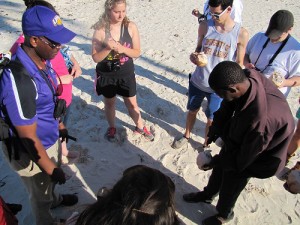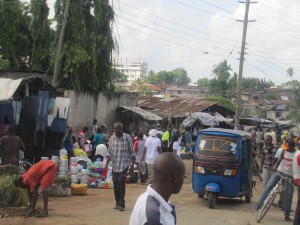Jambo! Wednesday 14 May was an adventurous day for our group.
It began as usual with our breakfast– a “working class” breakfast of 3 pieces of white bread with butter and mixed fruit jam and an egg. We were also served instant Africo coffee with hot milk, which is generally reserved for the higher classes who can afford such luxury. Post breakfast, we traveled back to the University of Dar es Salaam to pick up our guide for the city (Dr. Humbati of the U. of D.S. Geography Department).
Dr. Humbati offered a brief lecture that explained the urbanization of Dar es Salaam and Tanzania’s land ownership system which is all government owned– even private land is just leased out by the government. The city of Dar es Salaam has grown exponentially in the last 100 years, from 20,000 in 1899 to more than 5,500,000 in 2012. The hope of a job and upward mobility is enough of incentive to attract Tanzanians to its unofficial capitol city (the official capitol is Dodoma). A squatter’s system allows Tanzanians to “own” that land after 10 years of occupation so much of the houses and dwellings are makeshift with whatever materials can be found. We also discussed informal and formal economic systems– the informal economy dominates the landscape of downtown and surrounding Dar es Salaam (about 75% are in the informal sector)– vendors avoid paying the 18% Value Added Tax that formal businesses pay, it is the historical way of the peoples to sell in market-like environments like Karikoo and Tandale districts.
In my observations, this system is all about survival– there is no government assistance for those in poverty so they must provide for themselves and their families in whatever way possible. People will sell anything anywhere; as Dr. Humbati says, “every place is a place for market.”
As quickly as the city morphs into an omnipresent marketplace, it comes to a halt upon entering the district of international embassies and the upper class called Oyster Bay, Uganga, and Coco Beach. The street markets and vendors vanish from these districts, and the city now appears similar to an American city. Here, we stop and dip our toes in the Indian Ocean at Coco Beach where we were treated to some fresh coconut by Dr. Koti and an entertaining song and dance by a local Tanzanian.
The last adventure of the day was in the Mwenge market– a friendly open-air environment with incredible carvings, paintings, masks, Masi keepsakes, and more. The only way to shop at the Mwenge market is to haggle! It’s the way of the locals, and it is a great way to converse and participate in the culture. We made a few friends in the market and bargained our way to bags full of memorabilia to gift to friends and loved ones when we return home.


Discussion
No comments yet.